PosHYdon: The key to unlocking offshore hydrogen’s future energy potential
Hydrogen—even if you follow energy developments and news on a casual basis, one cannot have missed the interest in hydrogen. On July 8, the European Commission published strategies for the energy sector of tomorrow: the hydrogen strategy and the energy system integration strategy. With these schemes in place, the EU aims to make the energy sector sustainable, since it accounts for 75% of CO2 emissions.
Hydrogen is seen as a key enabler to achieving the objectives of the European Green Deal and Europe’s clean energy transition. Hydrogen has several energy and non-energy uses, from storing renewable energy to fueling heavy transport, and as energy and feedstock in energy-intensive industries, such as the steel and chemical sectors.
Most importantly, hydrogen is climate-friendly, as it does not emit any CO2 when used. It thus offers a solution to decarbonizing industrial processes and economic sectors, where reducing carbon emissions is both urgent and hard to achieve.
So, how can the oil and gas sector contribute? Gas and hydrogen are both molecule-based. Neptune Energy—together with partners—is keen to test the offshore production of green hydrogen on a live platform. Those lessons learned can unlock the future energy potential of large- scale offshore hydrogen.
Europe has the ambition of moving toward a climate-neutral energy system that has to be reliable and affordable. To achieve this, the North Sea has a key role to play—again. At first, decades ago, we achieved this with oil and gas production and now, increasingly, with renewable energy from offshore wind. The North Sea offers opportunities, not only for large-scale wind energy but also for hydrogen production and underground CO2 storage.
The Netherlands is particularly well-positioned to lead the transition to a hydrogen economy, given the abundance of wind energy and existing infrastructure at sea, and on land, for transporting gas and hydrogen molecules.
THE ROAD TO POSHYDON
The North Sea is where the energy transition is most visible now. Offshore gas is still an important component of the mix for a number of years, but that production will be coming to an end in the next decades, as fields become depleted. At the same time, offshore wind faces an exponential growth scenario in all countries surrounding the North Sea. In 2030, it is estimated that offshore wind parks will be able to provide the Netherlands with 11.5 GW of clean-but-intermittent power. That’s true if the wind blows, but then again, surely there is almost always a breeze offshore, isn’t there?
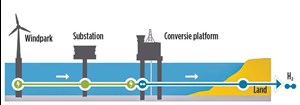
On the other end of the spectrum, what if it storms? Can we be sure that the national grid can handle all of this renewable offshore energy? Although TenneT, the Transport System Operator for the Netherlands, is working very hard to upgrade all infrastructure, chances are that there will be a need to curtail the wind turbines, when the wind blows too hard, around the year 2030. Wouldn’t that be a shame, if extensive renewable energy goes to waste?
So, the North Sea countries face challenges in both parts of the energy system, one based on electrons and the other based on molecules, when one looks at them as stand-alone sectors. What if these two sectors could integrate? Wise connections will reduce carbon emissions, reduce (societal) costs, make effective use of offshore space, protect nature and accelerate the energy transition. Good cooperation and coordination will enable the seizing of opportunities and put the North Sea on the map as a pioneering region for the European energy transition. This will provide an example to other regions of the world.
POSHYDON, THE PILOT
A key to unlocking the potential of integrating offshore energy systems is the PosHYdon pilot, a pioneering project to create the first offshore green hydrogen production plant in the Dutch North Sea. The aim of the pilot project is to gain experience in integrating working energy systems at sea and producing hydrogen in an offshore environment, Fig. 1.
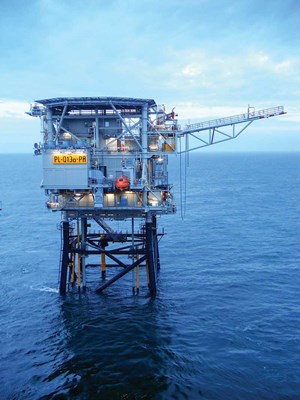
The pilot was commissioned by Nexstep, the Dutch Association for Decommissioning and Re-Use, and TNO, the Netherlands Organisation for applied scientific research in close collaboration with the industry. Gasunie, Noordgastransport BV, NOGAT BV, DEME Offshore and Eneco joined the PosHYdon consortium previously. NOGAT B.V. and Noordgastransport B.V. are both owners of large gas transport pipelines in the North Sea. Gasunie also plays an important role on the steering committee of the European Clean Hydrogen Alliance.
On July 4, 2019, the PosHYdon partners selected the location for this pilot. It will be sited on Neptune Energy’s Q13a-A platform, Fig. 2. Lex de Groot, Neptune Energy’s managing director in the Netherlands, is pleased with the European initiative.
“We see the opportunities of hydrogen as part of our future energy supply,” said de Groot. “That is why we immediately embraced the PosHYdon pilot. With this innovation, we will be the first in the world to test the offshore production and transport of green hydrogen from the Dutch North Sea. The results will be key to further development of green hydrogen production and of system integration in the North Sea. The potential is there and we, as the Netherlands, have the ideal starting position to lead the transition to a hydrogen economy. With the North Sea for production of wind energy and gas, and with an existing, extensive infrastructure at sea and on land for transporting both gas and hydrogen molecules. PosHYdon is an important step in unlocking this North Sea potential.”
PosHYdon integrates three energy systems in the North Sea: offshore wind, offshore gas and offshore hydrogen, all taking place on Neptune Energy’s Q13a platform. This production facility is in the Dutch North Sea, approximately 13 km off the coast from Scheveningen. The platform is well-suited for the ground-breaking project. As the first fully electrified offshore oil platform in the Dutch North Sea, it saves approximately 16.5 kilotonnes of CO2 per year. This is the equivalent of 115,500 airline flights from Amsterdam to Paris.
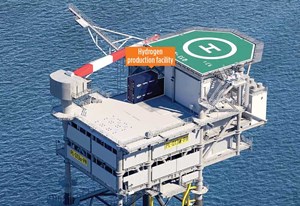
A 1.0-MW electrolyzer will be placed within a sea container and installed on the platform, Fig. 3. It will convert seawater to demineralized water and use green electricity from offshore wind to produce hydrogen, Fig. 4. The pilot will provide the participants with the opportunity to develop experience in producing hydrogen in an offshore environment, and it will create a testing ground for innovative technologies and integrated systems.
The PosHYdon pilot is envisioned to perform several test and demonstration functions. Areas of interest are to determine the dynamic load response of electrolyzer technologies; to evaluate the operational, inspection and maintenance requirements of offshore power to gas; to become a test center for Power 2 Gas technologies in an offshore environment; and to gain insight in hydrogen admixing in natural gas streams and the impact on industrial applications. The PEM type electrolyzer will be operated on a life production facility, which will remain in production during the one-year test.
LOOKING FORWARD
Given these key learning points, the Dutch North Sea is the perfect place to have conduct this pilot. it is a shallow body of water; there are already many active wind farms; there is a perfect gas grid infrastructure; and the two trunk transport pipelines, NOGAT and Noordgastransport; are already capable of transporting hydrogen and have the capacity to do so. In addition, those trunk lines make it possible to build wind farms further off the coast (over 100 km).
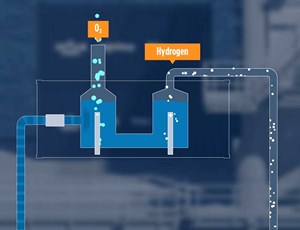
There is still plenty of room to accommodate increased energy demand, not only in the Netherlands, but internationally. Furthermore, the Dutch government has expressed a strong interest in making offshore wind and hydrogen a cornerstone for the clean energy system of the future in the Netherlands. Last but not least, major global players in offshore energy design, installation and operation have their bases in the Netherlands.
By combining hydrogen, offshore natural gas and offshore wind power, we can fuel our society, our economy, and the energy transition by supplying stable, affordable and clean energy.
APPENDIX: DETAILS ON SOME OF THE PARTNERS
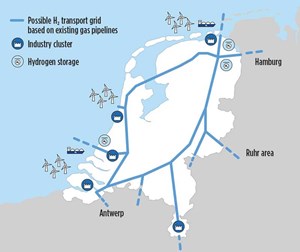
Gasunie, which manages and maintains infrastructure for large-scale transport and storage of gases in the Netherlands and northern Germany, joined the PosHYdon consortium following NOGAT B.V. and Noordgastransport B.V., both owners of large gas transport pipelines in the North Sea.
The company also plays a major role in the development of hydrogen. The firm is a member of the steering committee of the European Clean Hydrogen Alliance. Gasunie already has been working hard to accelerate the energy transition, including several hydrogen pilots on land, and has the necessary knowledge and experience with electrolysis in-house.
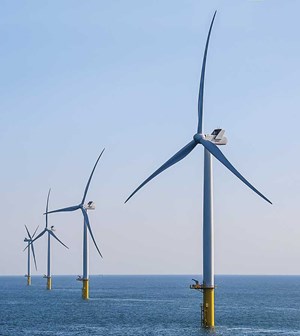
Gasunie will help to ensure that the two worlds, onshore and offshore, will literally be connected in terms of infrastructure. It is more than feasible to construct the basis for transport and storage of hydrogen to and from the major industrial areas in the Netherlands, and onward to Hamburg and the Ruhr area (Fig. 5), and have it ready as early as 2030.
Eneco, a leader in the field of sustainable energy, will supply simulated wind data from its offshore wind farm, Luchterduinen (Fig. 6), to support the PosHYdon project. The data will be used to accurately model the use of electricity generated by the windfarm to power the electrolysis process on the Q13a platform, using seawater. The seawater is demineralized on the platform, in order to produce hydrogen.
The Luchterduinen wind farm is located approximately 23 km off the coast of Zandvoort / Noordwijk and about 25 km north of the Q13a platform. There will be no direct connection between the wind turbines and the platform for this pilot. In addition to the technical aspect of offshore electrolysis, Eneco also has a strong interest in developing green hydrogen certificates and adding hydrogen to the natural gas network.”
DEME Offshore is a leader in offshore wind energy and green hydrogen production, and is bringing its expertise to the PosHYdon pilot as a partner. Part of the Belgian DEME Group, the company will provide the hydrogen unit for installation on the Neptune-operated Q13a platform.
DEME is a pioneer in the development, financing and construction of offshore energy projects and has an ongoing focus on new markets and opportunities. The combination of renewable energy with green hydrogen is fully consistent with its innovation vision, which is why DEME plans to invest in the development and large-scale production, storage and delivery of green hydrogen. For this, PosHYdon is a starting point.
DEME is involved in the conceptual design of the 100-MW offshore hydrogen gas production plant. The firm is also the Task Leader when evaluating the business case, in line with this 100-MW concept. The firm is also involved in the transport and installation of the onshore H2 unit on the Q13a platform.
Related Articles- Advancing offshore decarbonization through electrification of FPSOs (March 2024)
- Subsea technology- Corrosion monitoring: From failure to success (February 2024)
- Driving MPD adoption with performance-enhancing technologies (January 2024)
- Digital transformation: A breakthrough year for digitalization in the offshore sector (January 2024)
- Offshore technology: Platform design: Is the next generation of offshore platforms changing offshore energy? (December 2023)
- 2024: A policy crossroads for American offshore energy (December 2023)


